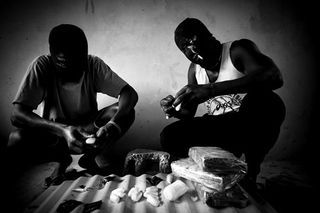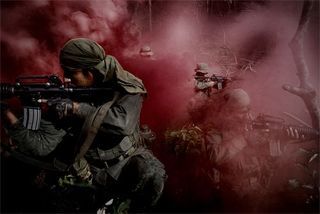Marco Vernaschi ©, for the Pulitzer Center
(Editor's note: This is the fourth of eight dispatches, recounting events surrounding the double assassinations of Guinea Bissau's president and army chief of staff last March and the country's emergence as a 'narco state.')
Al Qaeda and Hezbollah's long arms extend from West Africa to Latin America. The tri-border area where the frontiers of Brazil, Argentina and Paraguay meet is considered a trafficker's paradise. A number of drug cartels and terrorist groups affiliated with the Middle East operate in the frontier area, according to international agencies and the U.S. military, and it is viewed as a a nexus between South America and West Africa, especially Guinea Bissau and Nigeria.
This area is strategically critical for several criminal activities, as among them money laundering and smuggling, and it's the drop-off for air travel between South America and West Africa. The Brazilian government estimates that $12 billion is laundered annually through the tri-boder area; the U.S. Southern Command puts the annual total much higher, at between $50 to $500 billion.
Out of this diverse criminal activity emerged a terrorism-financing network, led by Lebanese clan of Assad Ahmad Barakat, who according to the FBI and the U.S. Treasury Department was a key financier to Hezbollah. Barakat was arrested by Brazilian and Paraguayan authorities working in cooperation with the U.S. Government but his clan kept on sending money to Lebanon and elsewhere in Africa.
The Lebanese network operating in Bissau is the next link in the chain. It acts to distribute the drugs but mostly provides the environmental conditions that keep the business alive. President Nino Vieira's policy during the last three years focused on allowing the Lebanese to do their business. In return he reaped considerable personal benefits, and the country itself benefited from a surge in foreign investments, mostly from the Middle East, that in in 2006 totaled over $42 million.
Put those numbers together and Tarek Aretzki's Palace Hotel starts to make a little more sense.
But Guinea Bissau's role and ties in Latin America drug trafficking dynamics is not limited to its connections with the Triple Frontier. During the last few months Buenos Aires has turned into one of the major points of shipment for the cocaine smuggled into Africa, in particular to Guinea Bissau and South Africa (where traffickers are storing big quantities for the 2010 World Championships).
On March 12th of this year, 10 days after Vieira was killed, the Argentinean Collection Agency declared that the Consulate of Guinea Bissau in Buenos Aires was involved in criminal activities related to money laundering, drug trafficking and illegal arms trade. What possible connection is there between Argentina and Guinea Bissau? Arms trafficked from Argentina to Bissau, but mostly the shipments consisted of the base ingredients to produce ephedrine and methamphetamines, trafficked from South America to West Africa and then smuggled through Mexico -- eventually to the U.S.. All supervised by the Lebanese network in the Triple Frontier and in Bissau with the cooperation of then President Nino Vieira, in partnership with South American and Mexican cartels.
The position of Consulate of Guinea Bissau in Buenos Aires was held by an unconventional Honorary Consul; Enrique Oscar Montinel, who according to the Argentinian army register had died on March 11th, 1997. When I met him in his office to get my visa, in January 2009, he was alive and well; he asked questions on the purpose of my trip for two hours. Montinel appeared a little concerned when I told him I was a journalist, so I explained that the intention of my trip was to write an article for a travel magazine, to promote tourism in his country. I'm not sure he believed my story, but he stamped a six months visa on my passport and gave me some local contacts, including the president's phone number. He told me he likes Italians.
The Argentinean authorities started to investigate this case by mid August 2008, when the corpses of Sebastián Forza, Damián Ferrón and Leopoldo Bina were found not far from Buenos Aires. The three had been killed in perfect mafia style, in mysterious circumstances and all of them were in, or connected to, the pharmaceutical business. A few months later Nestor Lorenzo, owner of the pharmaceutical Multipharma and a strong supporter of Argentina's President Cristina Fernández Kirchner, Esteban Pérez Corradi (investigated for supplying ephedrine), Martín Magallanes and Marcelo Abasto (pharmacy and drugstore owners) and Walter Pérez (arrested for illegal medicines trade) were all investigated for ephedrine trafficking and illegal trade of medicines, considered to be the base for ephedrine and crystal meth.
All these people were "clients" of the Consulate of Guinea Bissau, which used to change cash into checks or checks into cash. The Consulate received the checks, charged a fee, and made operations through ghost companies. All such companies were exempt from paying taxes on the checks and the entire business was held locally by a bunch of former military involved in arms trafficking.
The Argentinean Prosecutor, Javier López Biscayart , estimates that for these services the Consulate was able to change up to $2 million a day. On June 5th he brought that trade to at least a temporary halt, by ordering that the Consulate by seized, as well as other buildings that had been controlled by Enrique Oscar Montinel.



